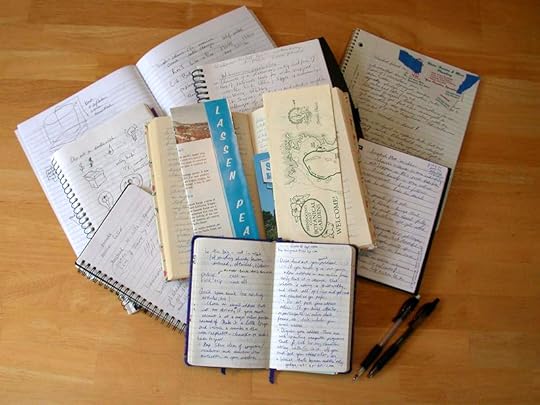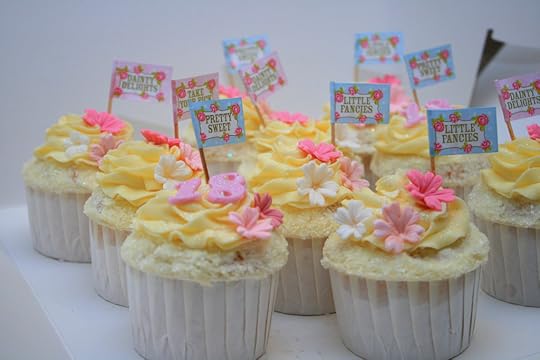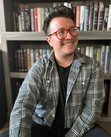Gabe Cole Novoa's Blog, page 11
September 22, 2017
On Reading Many Books at Once
 Photo credit: Dvortygirl on FlickrI used to be the kind of reader who could only read one book at a time. I'd often binge read and get through a book quickly—especially if I was enjoying it, especially especially if I was enjoying it and eager to read another book—but one book at a time was a firm rule for me.
Photo credit: Dvortygirl on FlickrI used to be the kind of reader who could only read one book at a time. I'd often binge read and get through a book quickly—especially if I was enjoying it, especially especially if I was enjoying it and eager to read another book—but one book at a time was a firm rule for me.Then I started doing literature programs in college and I didn't have the luxury of sticking to my one book at a time rule.
Granted, I suppose I could have added all the pages I needed to read in a week (adding together the page counts of the books I needed to read) and then gone through one book at a time that way, but for some reason I've found it's less daunting to read 50 pages of one book and 30 pages of another book and 35 pages of yet another book than it is to read 115 pages of a single book. Which is silly, I know, because I'm reading 115 pages a day either way, but it doesn't feel like it as much as it would if I was reading that amount from a single book.
After I broke that rule initially years ago now, I started occasionally pleasure-reading multiple books at once, oftentimes because I'd get a book I was really excited about and couldn't wait to read so I'd dive into that one while still reading another one. It's not something I did often but...#noregrets.
The other thing book hopping allows me to do is get through books I'm not enjoying as much (a necessity, in literature programs because invariably there will be books I have to read I'm not really into) in bite-sized pieces. I'll tell myself, okay, I'll read 50 pages of this book I don't love first, then I'll get to read 65 pages of those other books I do like.
Granted, reading several books at once means it takes me longer to finish all of them—but it evens out because I end up finishing a bunch of them within a couple days as I near the end of every book around the same time.
Moving to reading a bunch of books at once has actually been easier than I anticipated, although it's quickly becoming clear to me that pleasure reading is a thing that's probably going to be rare as long as I have three (or more) books in a week to read for school. But that's okay—I'm reading lots of books I probably wouldn't have otherwise—or at least wouldn't have so soon. And that's certainly not a bad thing.
Do you read multiple books at once?
Twitter-sized bites:
Do you read multiple books at once? Join the discussion on @Ava_Jae's blog. (Click to tweet)





Published on September 22, 2017 04:00
September 19, 2017
Vlog: 3 Types of Editing
You asked, I answered: what are the different types of editing and what is each helpful for? Today I'm talking the stages of editing and why each are equally important.
RELATED VLOGS:
Why I Revise in PassesHow Do You Know When You're Done Revising?First to Final Draft: BEYOND THE REDHow to Handle Tough CP Feedback
Twitter-sized bite:





RELATED VLOGS:
Why I Revise in PassesHow Do You Know When You're Done Revising?First to Final Draft: BEYOND THE REDHow to Handle Tough CP Feedback
Twitter-sized bite:
What are the 3 types of editing and why is each important? @Ava_Jae breaks it down in today's vlog. (Click to tweet)





Published on September 19, 2017 04:00
You asked, I answered: what are the different types of ed...
You asked, I answered: what are the different types of editing and what is each helpful for? Today I'm talking the stages of editing and why each are equally important.
RELATED VLOGS:
Why I Revise in PassesHow Do You Know When You're Done Revising?First to Final Draft: BEYOND THE REDHow to Handle Tough CP Feedback
Twitter-sized bite:





RELATED VLOGS:
Why I Revise in PassesHow Do You Know When You're Done Revising?First to Final Draft: BEYOND THE REDHow to Handle Tough CP Feedback
Twitter-sized bite:
What are the 3 types of editing and why is each important? @Ava_Jae breaks it down in today's vlog. (Click to tweet)





Published on September 19, 2017 04:00
September 15, 2017
How to Juggle Multiple Deadlines
 Photo credit: The Lowry, Salford on FlickrWriting deadlines are hard, and writing deadlines when you have more than one, and when writing deadlines aren't the only deadlines you have, and when writing isn't the only thing you do, is even harder.
Photo credit: The Lowry, Salford on FlickrWriting deadlines are hard, and writing deadlines when you have more than one, and when writing deadlines aren't the only deadlines you have, and when writing isn't the only thing you do, is even harder.I've been thinking a lot about that as I juggle my writing with my responsibilities, new and old.
Writing-wise, I currently have three projects I'm tossing around, two with deadlines (one self-imposed, one not), and a third that really wants my attention but has to sit and wait. On top of that are my freelance editing projects, my social media commitments, my part-time job, and grad school. And even before I've started doing all of those things at once—though I will have started by the time this publishes—I've already been thinking a lot about how to prioritize to make sure things get done.
For me, it starts with recognizing hard deadlines vs soft deadlines. Hard deadlines are deadlines I can't move—deadlines in contracts (both writing and freelance) or homework, for example. Hard deadlines I usually get plenty of advance notice on, so when I initially get them I sit down and do some math to figure out how much work I have to do every day in order to finish on time. And then I build in a few extra days, for days when things don't go as planned.
Conversely, soft deadlines are usually self-imposed deadlines. They're goalposts, rather than something someone else is waiting on—or, they're sometimes a hard deadline date with the wiggle room built in. So, if I've committed to finishing a project on the 31st, I'll usually math out so I finish on the 29th, so the 29th is my soft deadline that can be moved if needed, and the 31st is my hard deadline.
Once I've established all I need to do every day for each of my commitments, I prioritize within the day. My to-do list nowadays typically looks like this:
errandswriting/revision workfreelance workgrad school reading/worksocial media workWithin my grad school reading, I like it split it up between boring reading and fun reading. The boring reading I try to get out of the way first, and then the fun reading I know I can spread out throughout the day, even up until my bedtime reading. Social media work often gets priority unless I can push it off a day without consequence—but I try not to do that too much because I usually have plenty to do the next day too. Freelance work and writing work I generally prioritize the most, because the later in the day it gets, the less energy I have to do it—but those two categories frequently have the most hard deadlines, so I have to get them done. Then errands of course get prioritized and scheduled by how urgent they are.
By splitting up my tasks into bite-sized pieces and prioritizing them from most important to least, it allows me to get high-priority items done even when I have a lot going on while leaving some flexibility for overflow tasks that I can get done on a catch up day.
It's not a perfect system, but it definitely helps. And it's very necessary, for me at least, to keep track of all I need to do.
Do you prioritize your daily tasks?
Twitter-sized bite:
How do you juggle multiple responsibilities with writing? @Ava_Jae shares a few tips. (Click to tweet)





Published on September 15, 2017 04:00
September 14, 2017
Fixing the First Page Giveaway #39!
 Photo credit: EldrivaWe are somehow nearly halfway through September! Which means Fall is upon us and Halloween is creeping closer and it's time for the next Fixing the First Page giveaway! Yay!
Photo credit: EldrivaWe are somehow nearly halfway through September! Which means Fall is upon us and Halloween is creeping closer and it's time for the next Fixing the First Page giveaway! Yay!For those who’ve missed before, the Fixing the First Page features is a public first 250 word critique. Using the lovely rafflecopter widget, anyone interested in winning a public (as in, featured in a post on this blog) first page critique can enter.
For an example of what this critique will look like, here's the last Fixing the First Page post.
Rules!
ONLY the first 250 words will be critiqued (up to finishing the sentence). If you win and send me more, I will crop it myself. No exceptions.
ONLY the first page. I don’t want 250 random words from your manuscript, or from chapter 3. If you win the critique and send me anything other than the first 250 words of your manuscript, I will choose someone else.
I will actually critique it. Here. On the blog. I will say things as nicely as I can, but I do tend to be a little blunt. If you’re not sure you can handle a public critique, then you may want to take some time to think about it before you enter.
Genre restrictions. I'm most experienced with YA & NA, but I will still accept MG and Adult. HOWEVER. If your first page has any erotic content on it, I ask that you don’t enter. I want to be able to post the critique and the first 250 in its entirety without making anyone uncomfortable, and if you win and you enter a page with erotic content, I will choose someone else.
You must have your first page ready. Should you win, you need to be able to submit your first page within 48 hours of my contacting you to let you know you won. If 48 hours pass and I haven’t heard from you, again, I will choose someone else.
You’ll get the most out of this if it isn’t a first draft. Obviously, I have no way of knowing if you’re handing me a first draft (though I will probably suspect because it’s usually not that difficult to tell). I won’t refuse your page if it’s a first draft, but you should know that this critique will likely be of more use if you’ve already had your betas/CPs look over it. Why? Because if you don’t, the critique I give you will probably contain a lot of notes that your betas & CPs could have/would have told you.
There will not be a round 2 (unless you win again in a future contest). I hate to have to say this, but if you win a critique, it’s NOT an invitation to send me a bunch of your revisions. I wish I had the time available to be able to look at revisions, but sadly, I don’t. If you try to break this rule, I will nicely say no, and also remember to choose someone else should you win a second contest. Which would make me sad. :(
So that’s it! If you’re okay with all of the above and would like to enter to be the thirty-seventh public critique on Writability, do the thing with the rafflecopter widget below. You have until Thursday, September 21 at 11:59 PM EST to enter!
a Rafflecopter giveaway





Published on September 14, 2017 04:00
September 12, 2017
Vlog: How to Move Affordably with Lots of Books
Moving is expensive and moving when you have a lot of books, even more so. So today I'm sharing how I moved with over 100 books without breaking the bank.
RELATED VLOGS:
Discussion: Hardcover? Paperback? E-book?: http://bit.ly/2tQHQEJ Where to Find Books to Read: http://bit.ly/2tbrNnc
Have you ever moved with a sizable library?
Twitter-sized bite:





RELATED VLOGS:
Discussion: Hardcover? Paperback? E-book?: http://bit.ly/2tQHQEJ Where to Find Books to Read: http://bit.ly/2tbrNnc
Have you ever moved with a sizable library?
Twitter-sized bite:
Getting ready for a big move & not sure how to affordably transport your library? @Ava_Jae shares how they did it. (Click to tweet)





Published on September 12, 2017 05:12
September 8, 2017
On College and Authoring
 Photo credit: Sole Treadmill on FlickrI frequently get questions from writers about what degree they should do if they want to be a published author, or what I learned from my schooling so far that helped me get published. And up until very recently, where I've started schooling specifically for writing children's books, the truth was my schooling was a thing I did alongside my writing, not something I did specifically to write.
Photo credit: Sole Treadmill on FlickrI frequently get questions from writers about what degree they should do if they want to be a published author, or what I learned from my schooling so far that helped me get published. And up until very recently, where I've started schooling specifically for writing children's books, the truth was my schooling was a thing I did alongside my writing, not something I did specifically to write.Of course, my situation was not the same as many. I'd been writing all through high school and was largely self-taught. I devoured books on writing, blog posts from people in the industry, and wrote manuscript after manuscript. By the time I transferred over to my alma mater to get my BA in English, I already had an agent—and just two months into my BA degree I got my debut book deal.
So when people asked me up until recently if I went to school to be an author, it felt disingenuous to say yes. Because the truth was, my education hadn't really done much to make me a writer—I did that on my own.
Now things are a little different, however. Now I'm starting my MFA in Writing for Children, which is very much intended to further push me as a writer and also hopefully open up some doors for job opportunities down the road directly related to children's literature. But my main focus is very much to improve my skills and expand my writerly repertoire.
I do want to emphasize though: I didn't have to go to college to get published. No one does.
When I was first deciding what to do, college-wise, all the while knowing my ultimate goal was to become a published author, a degree became important to me not to help me write, but to help me get a job that'd allow me to support myself while I write. So I could've gotten a degree in just about anything, really, but after dipping my toes in the film world I decided I'd be happiest getting a job analogous to writing and children's books—even if not directly publishing-relating. That was the option I've decided was best for me, but that's not going to be the best option for everyone.
Some writers are also doctors, or analysts, or teachers, or fishers. Some are booksellers, or scientists, or nurses, or event planners. I think the main thing that's important when considering college is keeping your expectations grounded and understanding that making a living as a writer isn't easy and often takes a lot of time. So when considering college, I encourage writers to consider how they'd like to make a living outside of writing and then go from there.
Starting school specifically for writing will be a new experience for me—and one I'm looking forward to. But ultimately, for me, this was another step toward figuring out how to make a living in a way that I'd enjoy—and that requires openness and exploration I'm grateful to have the space for.
What do you think?
Twitter-sized bite:
Do you need to go to college to get published? @Ava_Jae shares their experience getting published while at school. (Click to tweet)





Published on September 08, 2017 04:00
September 1, 2017
What’s Driving Your Plot? by Janice Hardy
Hello, friends! Today I've got a special guest for you guise, Janice Hardy, author of The Healing Wars trilogy and several writing books, most recently Understanding Conflict (And What It Really Means). Hope you enjoy!
Conflict encompasses a wide scope of problems and situations, and can be as varied and interesting as you want to make it. But no matter what type of conflict a character faces, it presents a challenge in how to resolve the conflict. That challenge leads to a choice on the best course of action, and that choice forces the character to act. And that’s good, since those challenges, choices, and actions create and drive the plot (the combination of internal and external conflicts). Without conflicts, the protagonist would have no problems at all, and there'd be no story.
On one side, we have the external conflicts. These are challenges the protagonist has to physically overcome to resolve the core conflict problem (and all the smaller problems along the way). They’re the actions she takes to fix the problems preventing her from getting her goal. They’re what make up most of the action in the plot, since this is what the protagonist does from scene to scene.
For example:
Protagonist wants to find her missing sister, but someone has stolen the security tapes covering the parking lot she was last seen in.Protagonist wants to impress her date on their trail ride, but she has no idea how to ride a horse.Protagonist wants to surprise his girlfriend with breakfast in bed, but he has to get her kids out of the house first.
External conflicts are based on how the protagonist uses her intelligence, skills, and resources (or lack thereof) to overcome an external challenge. The key thing to remember with external conflicts is that resolving them takes action—the protagonist does something. While she might take a moment (or longer) to come up with a plan to overcome the challenge, it’s what she does that resolves it.
Generally speaking, the scene will unfold like this: The protagonist will be trying to achieve a goal when she’s presented with a challenge (she’s trying to do something in a scene and something stops her—the conflict). She’ll either react on instinct and try to overcome that challenge, or take time to decide what to do (how much time is up to the writer). The difficulty of the challenge, the level and type of conflict, and the competence of the protagonist determine how that challenge is resolved. What happens at the end of the challenge leads to the next goal of the plot and the next challenge.
This is essentially plotting in conceptual form. Pursue a goal, face a challenge, outsmart or overpower it, proceed to the next challenge with a new goal.
Of course, just watching someone complete a series of tasks can get boring after a while. Most external challenges just require skill, strength, or intelligence to overcome, others will be much harder to resolve due to personal issues. To counter potential task boredom, another layer of conflict is often added to keep the story interesting. This is where the internal conflicts kick in.
Internal conflicts are the emotional, ethical, or mental struggles a character faces while trying to decide what to do about an external problem. The challenge isn’t a physical thing in the way, but a struggle within the protagonist to make the right choice. It’s the mental and emotional debate the protagonist needs to have in order to resolve an external problem.
For example:
Protagonist wants to save her missing sister, but doing so will reveal a secret she can’t afford to have known.Protagonist wants to be loved, but her refusal to compromise keeps her alone.Protagonist wants to romance his girlfriend, but he doesn’t want to risk making her kids mad and their not liking him.
An external task that’s easy to complete can be made difficult by adding an emotional roadblock. What needs to be done is clear, but the protagonist doesn’t want to resolve it that way for personal reasons. Either the right choice has consequences she doesn’t want to suffer, or there is no good choice—whatever she does has serious ramifications.
Internal conflicts are based on who the protagonist is and what has happened to her in her life, and this past makes it harder for her to make decisions and resolve her external challenges. They typically come from the morals and ethics of the character, and more often than not, choosing one side negates the other and the protagonist can’t have it both ways.
Internal conflicts are great opportunities to put the protagonist in the hot seat and force her to decide who she is and what she stands for. How far is she willing to go to help a friend? What will she risk? What does she value? Her struggles while making a decision shows readers who she really is as a person.
Mixing the two create a plot- and story-driving engine that keeps readers invested in what problems might be faced and where the emotional challenges will come from. It not only piques readers’ interest about what could happen, but it makes them wonder why, and anticipate how the protagonist will overcome the conflict.
So, what’s driving your plot?
Looking for more tips on creating conflict? Check out my latest book Understanding Conflict (And What It Really Means), an in-depth guide to how to use conflict in your fiction.
Janice Hardy is the award-winning author of the fantasy trilogy, The Healing Wars , and multiple books on writing, including Understanding Show, Don't Tell (And Really Getting It), Planning Your Novel: Ideas and Structure and Revising Your Novel: First Draft to Finished Draft. She's also the founder of the writing site, Fiction University. For more advice and helpful writing tips, visit her at www.fiction-university.com or @Janice_Hardy.
Website | Facebook | Twitter | Goodreads | Amazon | Barnes & Noble | iTunes | Indie Bound





Conflict encompasses a wide scope of problems and situations, and can be as varied and interesting as you want to make it. But no matter what type of conflict a character faces, it presents a challenge in how to resolve the conflict. That challenge leads to a choice on the best course of action, and that choice forces the character to act. And that’s good, since those challenges, choices, and actions create and drive the plot (the combination of internal and external conflicts). Without conflicts, the protagonist would have no problems at all, and there'd be no story.
On one side, we have the external conflicts. These are challenges the protagonist has to physically overcome to resolve the core conflict problem (and all the smaller problems along the way). They’re the actions she takes to fix the problems preventing her from getting her goal. They’re what make up most of the action in the plot, since this is what the protagonist does from scene to scene.
For example:
Protagonist wants to find her missing sister, but someone has stolen the security tapes covering the parking lot she was last seen in.Protagonist wants to impress her date on their trail ride, but she has no idea how to ride a horse.Protagonist wants to surprise his girlfriend with breakfast in bed, but he has to get her kids out of the house first.
External conflicts are based on how the protagonist uses her intelligence, skills, and resources (or lack thereof) to overcome an external challenge. The key thing to remember with external conflicts is that resolving them takes action—the protagonist does something. While she might take a moment (or longer) to come up with a plan to overcome the challenge, it’s what she does that resolves it.
Generally speaking, the scene will unfold like this: The protagonist will be trying to achieve a goal when she’s presented with a challenge (she’s trying to do something in a scene and something stops her—the conflict). She’ll either react on instinct and try to overcome that challenge, or take time to decide what to do (how much time is up to the writer). The difficulty of the challenge, the level and type of conflict, and the competence of the protagonist determine how that challenge is resolved. What happens at the end of the challenge leads to the next goal of the plot and the next challenge.
This is essentially plotting in conceptual form. Pursue a goal, face a challenge, outsmart or overpower it, proceed to the next challenge with a new goal.
Of course, just watching someone complete a series of tasks can get boring after a while. Most external challenges just require skill, strength, or intelligence to overcome, others will be much harder to resolve due to personal issues. To counter potential task boredom, another layer of conflict is often added to keep the story interesting. This is where the internal conflicts kick in.
Internal conflicts are the emotional, ethical, or mental struggles a character faces while trying to decide what to do about an external problem. The challenge isn’t a physical thing in the way, but a struggle within the protagonist to make the right choice. It’s the mental and emotional debate the protagonist needs to have in order to resolve an external problem.
For example:
Protagonist wants to save her missing sister, but doing so will reveal a secret she can’t afford to have known.Protagonist wants to be loved, but her refusal to compromise keeps her alone.Protagonist wants to romance his girlfriend, but he doesn’t want to risk making her kids mad and their not liking him.
An external task that’s easy to complete can be made difficult by adding an emotional roadblock. What needs to be done is clear, but the protagonist doesn’t want to resolve it that way for personal reasons. Either the right choice has consequences she doesn’t want to suffer, or there is no good choice—whatever she does has serious ramifications.
Internal conflicts are based on who the protagonist is and what has happened to her in her life, and this past makes it harder for her to make decisions and resolve her external challenges. They typically come from the morals and ethics of the character, and more often than not, choosing one side negates the other and the protagonist can’t have it both ways.
Internal conflicts are great opportunities to put the protagonist in the hot seat and force her to decide who she is and what she stands for. How far is she willing to go to help a friend? What will she risk? What does she value? Her struggles while making a decision shows readers who she really is as a person.
Mixing the two create a plot- and story-driving engine that keeps readers invested in what problems might be faced and where the emotional challenges will come from. It not only piques readers’ interest about what could happen, but it makes them wonder why, and anticipate how the protagonist will overcome the conflict.
So, what’s driving your plot?
Looking for more tips on creating conflict? Check out my latest book Understanding Conflict (And What It Really Means), an in-depth guide to how to use conflict in your fiction.
Janice Hardy is the award-winning author of the fantasy trilogy, The Healing Wars , and multiple books on writing, including Understanding Show, Don't Tell (And Really Getting It), Planning Your Novel: Ideas and Structure and Revising Your Novel: First Draft to Finished Draft. She's also the founder of the writing site, Fiction University. For more advice and helpful writing tips, visit her at www.fiction-university.com or @Janice_Hardy.
Website | Facebook | Twitter | Goodreads | Amazon | Barnes & Noble | iTunes | Indie Bound





Published on September 01, 2017 04:00
August 29, 2017
Vlog: On Making Changes Part-Way Through a Draft
So you're part-way through your first draft, and then you realize...your story's headed in the wrong direction. Or you need to make a major change. Or both. But how do you handle this realization when partway through your first draft?
RELATED VLOGS:
On Consistency While First Drafting4 Fast Drafting TipsOn (Terrible) First DraftsWhat if Your Writing Sucks?
Twitter-sized bite:





RELATED VLOGS:
On Consistency While First Drafting4 Fast Drafting TipsOn (Terrible) First DraftsWhat if Your Writing Sucks?
Twitter-sized bite:
What do you do if you realize mid-1st draft you've made a big mistake? @Ava_Jae talks handling first draft trip ups. (Click to tweet)





Published on August 29, 2017 04:33
August 25, 2017
Fixing the First Page Feature #38
 Photo credit: Matt Henry photos on FlickrSeptember is nearly here, retail stores are transitioning to their fall collections, and summer is at an end. But of course, the end of the month means it's time for the next Fixing the First Page feature!
Photo credit: Matt Henry photos on FlickrSeptember is nearly here, retail stores are transitioning to their fall collections, and summer is at an end. But of course, the end of the month means it's time for the next Fixing the First Page feature! As usual, I'll start by posting the full first 250 excerpt, after which I'll share my overall thoughts, then my redline critique. I encourage you guys to share your own thoughts and critiques in the comments (because I'm one person with one opinion!), as long as it's polite, thoughtful, and constructive. Any rude or mean comments will be unceremoniously deleted.
Here we go!
Title: DRAWN IN 2
Genre/Category: YA fantasy (light)
First 250 words:
"She's dazed, the white of her nightshirt standing out like a beacon in the moonlit forest, but it's the circle of guns pointed at her that captures my attention. Four Enforcers surround her, and as I watch from my hiding place behind an oak tree and try to get my bearings, inexplicably, they laugh.
'A little confused, Traveler?' It's the leader who speaks, his rough voice amused at this poor girl's blinking bewilderment. If his beefy stature towering over the others isn't clue enough that he's in charge here, his unremarkable unhandsome face is. It's Donovan, and although the fact that he's not currently threatening me is a nice change, I still shiver, knowing exactly what this stranger in pajamas is feeling.
'Am I... am I dreaming?' She turns a full circle, taking in the men surrounding her. She tosses her long black hair over one shoulder and tentatively reaches out to touch the barrel of one of the guns. 'It feels so real.'
My pulse speeds up and I steady myself, leaning into the tree. I should intervene somehow, do something. But what? I'm as unprepared as this girl is, ripped from my bed in the middle of the night—no warning, no weapon--just me in my Ravenclaw PJs, bare feet sinking into the soft grass. At least I've been here before. This Traveler isn’t quite as savvy.
Donovan sneers. 'Dreaming, huh? Funny, that's what they all think. I keep hoping one of you will be original someday.'"
Interesting start! I like that we're starting in medias res (which is my personal favorite kind of opening), and some of the details and thoughts in there from the narrator definitely helped ground me, even as I tried to figure out what was going on. All in all, pretty well-built foundation here.
Now for the line edits!
"She's dazed, the white of her nightshirt standing out like a beacon in the moonlit forest, but it's the a circle of guns pointed at her that captures my attention. Adjustment made both to cut wordiness and remove filtering. Four Enforcers surround her, and as I watch from my hiding place behind an oak tree and try to get my bearings, inexplicably, they laugh.
'A little confused, Traveler?' It's tThe leader who speaks, his rough voice amused at this poor girl's blinking bewilderment. If his beefy stature towering over the others isn't clue enough that he's in charge here, his unremarkable unhandsome face is. It's Donovan, and although the fact that he's not currently threatening me is a nice change, I still shiver, knowing exactly what this stranger in pajamas is feeling. Again, suggested cuts are to lessen wordiness and remove filtering.
'Am I... am I dreaming?' She turns a full circle, taking in the men surrounding her. She tosses her long black hair over one shoulder and tentatively reaches out to touch the barrel of one of the a guns. 'It feels so real.'
My pulse speeds up and I steady myself, leaning into the tree. I should intervene somehow, do something. But what? I'm as unprepared as this girl is, ripped from my bed in the middle of the night—no warning, no weapon—just me in my Ravenclaw PJs, bare feet sinking into the soft grass. Love the Ravenclaw PJs detail! Not only is it a great image but it tells me a little more about your protagonist. At least I've been here before. This Traveler isn’t quite as savvy.
Donovan sneers. 'Dreaming, huh? Funny, that's what they all think. I keep hoping one of you will be original someday.'"
Okay! So the main thing I'm noticing here is wordiness throughout, which is super common, so no worries. I recommend going through your manuscript and reading it aloud—that can help make it easier to spot when you're saying something in five words you can say in two, or when the flow stumbles.
Otherwise, I think this is a pretty solid start. I'm definitely intrigued, and if I saw this in the slush I'd totally keep reading. :)
I hope that helps! Thanks for sharing your first 250 with us, Sioux!
Twitter-sized bite:
.@Ava_Jae talks wordiness, details and more in the 38th Fixing the First Page Feature. (Click to tweet)





Published on August 25, 2017 04:00



